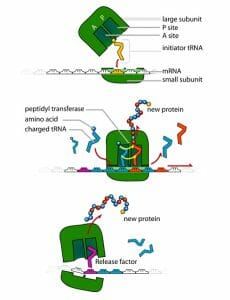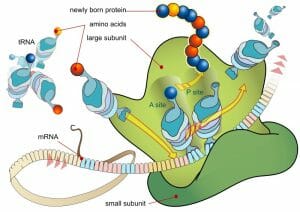Ribosome Definition
A ribosome is a complex cellular mechanism used to translate genetic code into chains of amino acids. Long chains of amino acids fold and function as proteins in cells.
Function of a Ribosome
The function of a ribosome in any cell is to produce proteins. Proteins are used in almost all cellular functions; as catalysts they speed the time of reactions, as fibers they provide support, and many proteins function in specific tasks, like contracting muscle cells. All proteins start as deoxyribonucleic acid, or DNA. A special protein, RNA polymerase, is an enzyme that recognizes sequences in the DNA, binds to them with the help of other proteins, and creates a new information molecule which can travel from the nucleus to the cytosol of the cell. The strand of ribonucleic acid (RNA) produced by RNA polymerase is processed on its way out of the nucleus, and areas of the RNA that do not code for proteins are removed. The molecule is now known as a messenger RNA or mRNA.
Every mRNA is made of 4 different nucleic bases, known as nucleic acids. The base pairs are “read” in series of threes, making up codons. Each codon specifies a specific amino acid. All life on Earth uses the same 20 amino acids, and the codons used to call for those amino acids are nearly universal. The codon that starts all proteins is “AUG”. This stands for the sequence of nucleic bases: adenine, uracil, and guanine, respectively. A special RNA molecule that can bind to amino acids, known as a transfer RNA or tRNA, recognizes this sequence and binds to it. This particular tRNA carries a methionine amino acid. Depending on the protein being built, the next amino acid could be any one of the twenty.
This is where the ribosome comes in. Recognizing the structure of the mRNA bound to a tRNA, the two subunits of the ribosome (discussed below) can combine to start synthesizing protein from the mRNA strand. The ribosome acts as a large catalyst, forming peptide bonds between amino acids. The used tRNA is released back into the cytosol so it can bind to another amino acid. Eventually, the mRNA will present a codon to the ribosome that means “stop”. Special proteins will detach the string of amino acids from the last tRNA, and the protein will be released. This process of synthesizing new protein is pictured in the image below:
Different proteins require different modifications and transport to various areas of the cell before they can function. A ribosome attached to the endoplasmic reticulum, for example, will deposit the newly formed protein inside, where it can be further modified and folded properly. Other proteins are formed directly in the cytosol where they can start acting as catalysts for various reactions. Ribosomes create all of these proteins that cells need, which is a lot. Per cell weigh, proteins account for about 20 percent. An average cell can have 10,000 different proteins, with on average a million copies of each. That is a lot of protein that must be synthesized, which is why the ribosome has evolved to be an efficient and speedy machine. On average, ribosomes can add 3-5 amino acids per second to a protein chain. Given that the largest known protein, titin, is around 30,000 amino acids, it only takes a ribosome 2-3 hours to synthesize. Short proteins, of only a few hundred amino acids, can be synthesized in minutes.
Once made, ribosomes cannot shut off. As soon as a tRNA has bound to an mRNA, they attach with the help of various other proteins, and the process of protein synthesis is initiated. Viruses have taken advantage of this fact. A virus is a small strand of DNA or RNA that replicates by hijacking a cell’s normal machinery, including ribosomes. The ribosomes of a cell are used by the virus to create proteins needed for it to replicate its genome and encapsulate itself so it can leave the cell. When a virus injects its genome into a cell, the molecule is treated the same as if the cell had created it. If the virus is DNA-based, the DNA makes its way into the nucleus, where the cell’s proteins translate it into RNA, which is translated by ribosomes into proteins. If the virus is RNA-based the viral RNA stays in the cytoplasm, where it can interact with ribosomes directly, creating new proteins. Either way, the virus will be able to create all the proteins required to replicate its genome and package the copies in new protein capsules, able to travel to a new host cell and spread the disease.
Structure of a Ribosome
Ribosomes have an incredibly similar structure throughout all forms of life. Scientists attribute this to the ribosome being a very effective and efficient way of synthesizing proteins. Thus, early in the evolution of the various forms of life, the ribosome was universally adopted as the method for translating RNA into proteins. Ribosomes therefore change very little between different organisms. Ribosomes consist of a large and small subunit, which come together around an mRNA molecule when translation takes place. Each subunit is a combination of proteins and RNA, called ribosomal RNA (rRNA). This rRNA is exists in various strands of different length, and is surrounded by the many proteins that create a ribosome. The rRNA acts both to secure the mRNA and tRNA in the ribosome, and as a catalyst to speed the formation of peptide bonds between amino acids.
The small subunit, as seen in the image above, helps to hold the mRNA in place as the ribosome translates it into protein. The larger subunit has various sites involved with different parts of the protein synthesis process. When the tRNA first binds to the mRNA, the P site can bind to these molecules. The P site is named after the polymerization, or construction of polymers, that occurs there. Conformational changes occur in the proteins of the ribosome which causes it to change shapes during the various steps of protein synthesis. As amino acids are added to the chain, tRNAs move from the A site (where new amino acids with tRNAs enter) to the P site, and eventually to the E site (not pictured), where they exit the ribosome without their amino acid. The rRNA that is associated with the ribosome helps attach to the tRNAs as they move through the ribosome, and has been found to help catalyze the formation of peptide bonds. This RNA is known as a ribozyme, or RNA catalyst.
One notable difference between prokaryotic and eukaryotic ribosomes is size. Ribosomes are measured in Svedberg units, which are a measure of how long it takes a molecule to sediment out of solution in a centrifuge. The larger the number, the larger the molecule. Prokaryotic ribosomes are typically 70S, or Svedberg units. A eukaryotic ribosome is usually 80S. Eukaryotic ribosomes are larger because they contain more proteins and more RNA. Prokaryotic ribosomes contain 3 RNA molecules, while eukaryotic ribosomes contain 4 RNA molecules. The differences are subtle, as the ribosomes of each operate in much the same way.
Related Biology Terms
- Ribozyme – RNA that acts as a biological catalyst, which in a ribosome helps form peptide bonds.
- Ribosomal RNA – RNA molecules associated with ribosomes, some of which are ribozymes and catalyze reactions.
- Ribonucleic Acid – Otherwise known as RNA, this molecule usually exists as a single-stranded carrier of genetic information.
- Deoxyribonucleic Acid – DNA, or the double-stranded and very stable molecule that contains the genetic information of most life on earth in the form of variable sequences of 4 different base-pairs.
Quiz
1. A scientist studying viruses is trying to find a way to stop them from reproducing. The scientist finds a way stop ribosomes from forming, which he determines also stops viruses from reproducing. Why will this method not work?
A. The virus can still reproduce its genome.
B. The host cell also needs the ribosomes.
C. The virus will not be able to enter the host cell.
2. Ribosomes and DNA produce millions of different proteins. How do millions of different proteins come from only 4 different nucleobases used to make DNA?
A. Ribosomes translate the 4 base language of DNA into the 20 base language of proteins, allowing for many more combinations.
B. The 4 different nucleobases of DNA can be recombined endlessly to produce new proteins.
C. Ribosomes can modify proteins with carbohydrates to make them unique.
3. A mad scientist wants to create a glowing rabbit that he can have as his companion. He removes the genes that cause glowing from a phosphorescent bacteria and inserts them into the embryo of a white rabbit. To his disappointment, the rabbit does not glow. Why didn’t his experiment work?
A. He used bacterial DNA, which creates bacterial proteins that do not function in DNA.
B. The ribosomes were not able to identify the mRNA produced by the gene.
C. The gene was never transcribed into mRNA.


